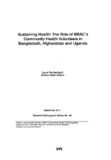Sustaining health: the role of BRAC's community health volunteers in Bangladesh, Afghanistan and Uganda
Citation
Reichenbach, L., & Shimul, S. N. (2011, September). Sustaining health: the role of BRAC’s community health volunteers in Bangladesh, Afghanistan and Uganda. Research Reports (2011): Economic Studies, Vol - XXVIII, 224–333.Abstract
This study fills an important gap in current understanding about a critical aspect of
BRAG's health programmes - the financial sustainability of the community health
volunteers (commonly referred to as Shasthya Shebikas in Bangladesh) that are the
cornerstone of BRAG's health programmes. Shasthya Shebikas (SS) are a cadre of
female volunteers that are recruited and trained by BRAG to provide a range of
essential healthcare services to their communities. What is unique about BRAG's
approach is that, while these women can be considered volunteers they do not
receive a salary or monthly stipend, they are provided with financial incentives on the
sale of basic medicines and selected health commodities to their community. This
sets BRAG apart from other health programmes that rely on either entirely salaried or
volunteer cadres of community health workers (GHW) and raises important questions
about the financial and programmatic sustainability and replicability of BRAG's
approach.
GHWs like the SSs play a crucial role in terms of human resources for health in
Bangladesh and other countries. The 2007 Bangladesh Health Watch reports a
shortage of 800,000 health workers in Bangladesh. Relying on formal institutions to
train health workers requires significant time and financial investment, therefore, the
SSs can be a critical and cost-effective input into the provision of essential health
services in Bangladesh. BRAG was among the first organization to set up a
community health volunteer (GHV) programme in Bangladesh in the 1970s. Its
original GHV programme recruited and trained male paramedics to treat minor illness
for which they received a small fee for referrals. Lessons from BRAG's early GHV
experience included issues related to remuneration, supervision and accountability.
BRAG addressed these issues by recruiting and training cadres of female health
volunteers. Since then, BRAG has adapted and revised the programme in response
to programmatic and community needs and has effectively scaled up the
programme from 1,080 SSs in 1990 to 80,000 SSs operating in 64 districts in
Bangladesh today. The SSs are an impressive force in terms of their numbers,
geographic coverage, and quick mobilization. The 80,000 SSs provide home visits to
18 million households every month (BRAG 2009).
The BRAG Health Programme operating model clearly relies on the successful
recruitment. training, and retention of female GHVs. The rationale for BRAG's
approach is that community-based financial incentives of a volunteer community
health workforce can achieve wide programme coverage and respond to community
essential healthcare needs while providing income opportunities to its female
volunteers.

